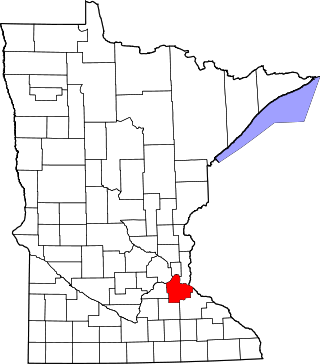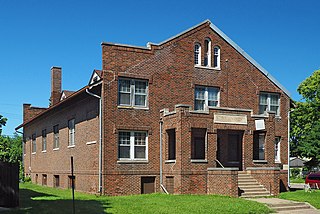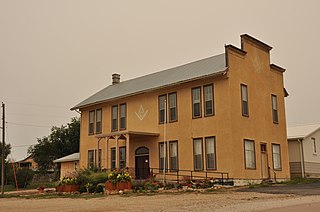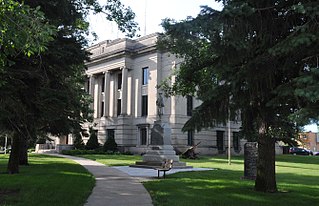The Nebraska Department of Transportation (NDOT) is the state government agency charged with building and maintaining the state highways in the U.S. state of Nebraska, as well as the state's airports. The main headquarters of the agency is located in Lincoln, the capital city. There are currently eight NDOT district offices located across the state.

The Mother Mosque of America, once known as The Rose of Fraternity Lodge, in Cedar Rapids, Iowa, United States, is the oldest standing purpose-built mosque in the United States, having been completed in 1934. The Al-Sadiq Mosque in Chicago and the Powers Street Mosque are older by a decade but were converted from existing buildings to be used as a Muslim house of worship.

This is a list of the National Register of Historic Places listings in Dakota County, Minnesota. It is intended to be a complete list of the properties and districts on the National Register of Historic Places in Dakota County, Minnesota, United States. Dakota County is located in the southeastern part of the U.S. state of Minnesota, bounded on the northeast side by the Upper Mississippi River and on the northwest by the Minnesota River. The locations of National Register properties and districts for which the latitude and longitude coordinates are included below, may be seen in an online map.

The Serbian Home is a two-story brick building, that was built in 1924 in South Saint Paul in the U.S. state of Minnesota. It was built as a community center for Serbian immigrants who worked in the meatpacking industry. It served as a museum respecting the multitude of ethnic groups who have made the city their home until 2020, when it was purchased and renovated by Serbian immigrant Aleksandar Stojmenovic to serve as an event center.

The District No. 72 School represents small, rural school-houses in Dakota County in the U.S. state of Minnesota. It was built in 1882, with a bell-tower, clapboard siding, a steep gabled roof, and pediments. It continues to be used as a community center and township hall. It is now known as the Waterford Community Center.

The Sioux Quartzite is a Proterozoic quartzite that is found in the region around the intersection of Minnesota, South Dakota, and Iowa, and correlates with other rock units throughout the upper midwestern and southwestern United States. It was formed by braided river deposits, and its correlative units are thought to possibly define a large sedimentary wedge that once covered the passive margin on the then-southern side of the North American craton. In human history, it provided the catlinite, or pipestone, that was used by the Plains Indians to carve ceremonial pipes. With the arrival of Europeans, it was heavily quarried for building stone, and was used in many prominent structures in Sioux Falls, South Dakota and shipped to construction sites around the Midwest. Sioux Quartzite has been and continues to be quarried in Jasper, Minnesota at the Jasper Stone Company and Quarry, which itself was posted to the National Register of Historic Places on January 5, 1978. Jasper, Minnesota contains many turn-of-the-century quartzite buildings, including the school, churches and several other public and private structures, mostly abandoned.

Hermosa Masonic Lodge is an historic Masonic building located in Hermosa, South Dakota, United States. In 1926 Battle River Lodge No. 92 of Hermosa bought the 1889 Hermosa School, stripped it of its brick veneer, belfry and end gable and moved it to what is now 33 North 2nd Street where the remaining wooden shell was converted into a lodge hall. The exterior walls were stuccoed and a false front was added.

Wewela is an unincorporated community in Tripp County, South Dakota, United States. Wewela is located on U.S. Route 183 near the Nebraska border, south of Colome.

North Dakota State University District is a 36-acre (15 ha) historic district on the campus of North Dakota State University, in Fargo, North Dakota, that was listed on the National Register of Historic Places in 1986.

The Larimore City Hall is a building in Larimore, North Dakota that was listed on the National Register of Historic Places in 1990. It "may be described as a two-and-a-half story rectangular structure of red-painted buff brick which rises to a hipped roof."
Standard Bridge Company was an American bridge company that was "one of the most important bridge building firms in Nebraska history."

Wenona Hall and Wecota Hall at South Dakota State University in Brookings, South Dakota are women's dormitories that were built in 1909 and 1915. John J. Schwartz was architect. The combination was listed on the U.S. National Register of Historic Places in 1980.
The South Prairie Community Hall near Minot, North Dakota was built in 1920. It was listed on the National Register of Historic Places in 2006.
St. Mary's Church, School and Convent is a historic Roman Catholic church complex off United States Route 212 in Zell, South Dakota.

Savo Hall, also known as the Finnish National Society Hall, is a historic meeting hall in Savo Township, Brown County, South Dakota. The hall was constructed in 1899 to serve as a meeting place for Savo's Finnish-American community. The Finnish National Society of Savo, formed the previous year, built the hall; the society consisted of Finnish-American residents of the area and largely consisted of members of the local Finnish Evangelical Lutheran Church. The hall hosted a variety of social functions, including theatrical and musical shows, sporting events, and temperance meetings. Of the four Finnish-American social halls built in South Dakota, the hall is the only one still in existence.

The International Vinegar Museum is located at 500 Main Street in Roslyn, South Dakota, United States. The museum is located in the former Roslyn Auditorium, a Depression-era brick building built in 1936 with funding from the Works Progress Administration. The building was listed on the National Register of Historic Places in 2001. The museum opened in 1999 and bills itself as the first museum dedicated to the subject of vinegar, with exhibits in its manufacture and use.

The Waldorf Hotel was a historic hotel building on Main Street in Andover, South Dakota. It was a three-story orange brick building with a rounded projecting section at the street corner. A single-story porch with turned posts and bracket extended along two sides of the building. The hotel was built in 1903, primarily to serve passengers switching from one railroad line to another. It featured a barber shop, a billiard hall and a huge dining room and reception room. It also acted as a social center in the community, hosting ice cream socials and dances.

Columbus City Hall is the city hall of Columbus, Ohio, in the city's downtown Civic Center. It contains the offices of the city's mayor, auditor, and treasurer, and the offices and chambers of Columbus City Council.

Ursa Louis Freed was an American architect active in North and South Dakota. A number of his works are listed on the U.S. National Register of Historic Places. He was a member of the American Institute of Architects from 1951 until his death in 1957.

Dr. Steven's House at 21 S. Riverview Heights in Sioux Falls, South Dakota, was built in 1926 for local physician George Stevens and his wife Nelle. It is located directly facing the Sioux Falls Veteran's Hospital.

















